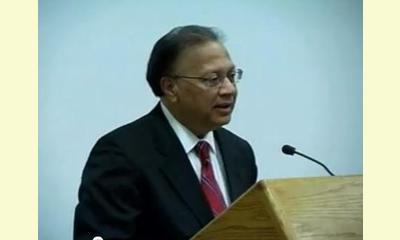|
|
Anwarul Chowdhury: Building a Culture of Peace Lecture
un articulo por David Adams
Video: Anwarul Chowdhury: Culture of Peace
The Center for Global Studies at Worcester State University (WSC) presented the lecture "Building a Culture of Peace" featuring guest speaker, former U.N. Ambassador and president of the UN Security Council, Anwarul K. Chowdhury, on 13 November 2007. Ambassador Chowdhury is introduced on the video by WSC President Janelle Ashley, and Dr. Joseph Baratta, WSC Professor of History and Political Science.

click on photo to enlarge
In the video, Ambassador Chowdhury describes how the culture of peace begins in the attitudes and behaviors of each person. As stated by Mahatma Gandhi, "We must be the change we wish to see." For this reason, he puts emphasis on education for a culture of peace.
Ambassador Chowdhury has played a key role in the development of the Global Movement for a Culture of Peace since 1999 when it was called for in the Declaration and Programme of Action on a Culture of Peace, of the United Nations General Assembly. Ambassador Chowdhury was responsible for the adoption of this resolution which involved an arduous nine-month process of negotiations in 1999, as described in the Early History of the Culture of Peace. At that time he was the Ambassador to the United Nations from Bangladesh. In presenting the resolution, the Ambassador said that it brought in subjects that the Assembly had rarely touched in its 50 year history: "I believe that this document is unique in more than one way. It is a universal document in the real sense, transcending boundaries, cultures, societies and nations. Unlike many other General Assembly documents, this document is action-oriented and encourages actions at all levels . . . All people from all walks of life and all sorts of backgrounds can contribute to its implementation."
Addressing the NGO Conference at UNESCO on 25 November 2000, he stated, "For the success of our movement, we need a 'grand alliance' for a culture of peace. During the on-going International Year for the Culture of Peace, we have seen such a grand alliance come together through the national committees and national focal points developed during the year, through projects implemented nationally and locally; through widespread involvement of civil society; through declaratory statements by regional organizations; through symposiums and workshops and seminars held all over the world; we are witnessing the movement gather a momentum that cannot be reversed."
Also in 1999, when he served as the rotating President of the UN Security Council, Ambassador Chowdhury was responsible for the adolption of Resolution 1325 to promote the role of women in UN peace initiatives. For its ongoing significance see the CPNN discussion of the Resolution 1325.
In recent years, Ambassador Chowdhury has served as Under-Secretary-General and High Representative for the Least Developed Countries, Landlocked Developing Countries and Small Island Developing States, and in 2010 he served as adviser to the President of the General Assembly. He continues to promote the culture of peace at every opportunity.
|








|
DISCUSSION
Pregunta(s) relacionada(s) al artículo :
Understanding the culture of peace, What are the key videos?
* * * * *
Comentario más reciente:
:
To begin this discussion, here are videos from three people who first developed the culture of peace concept at UNESCO and the United Nations:
Anwarul Chowdhury: Culture of Peace
David Adams: Culture of Peace
Federico Mayor: Culture of Peace
Federico Mayor: Cultura de Paz

|
|









